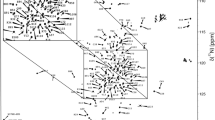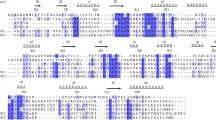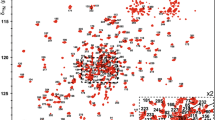Abstract
Human lysyl aminoacyl tRNA synthetase (hLysRS) is a multi-functional aminoacyl tRNA synthetase which is primarily involved in protein biosynthesis as well as crucial processes ranging from proinflammatory response to signal transduction. One important, non-canonical function of hLysRS is to target tRNALys,3, the HIV-1 reverse transcription primer molecule, for uptake and packaging into new HIV-1 particles. Since the anticodon binding (ACB) domain of hLysRS is required for proper recognition of its cognate tRNA, NMR studies of the ACB domain are being conducted to enhance our understanding of how hLysRS interacts with these RNAs during protein biosysnthesis as well as HIV-1 viral packaging. Here, we report the backbone and side chain NMR resonance assignments of the uniformly 15N-, 13C-labeled ACB domain of hLysRS.


Similar content being viewed by others
References
Alexandrescu AT, Jaravine VA, Dames SA, Lamour FP (1999) NMR Hydrogen Exchange of the OB-fold Protein LysN as a Function of Denaturant: The Most Conserved Elements of Structure are the Most Stable to Unfolding. J Mol Biol 289:1041–1054
Cavanagh J, Fairbrother W, Palmer A, Skelton N, Rance M (2007) Protein NMR spectroscopy. principles and practice. Academic Press, second edition
Cen S, Khorchid A, Javanbakht H, Gabor J, Stello T, Shiba K, Musier-Forsyth K, Kleiman L (2001) Incorporation of Lysyl-tRNA Synthetase into Human Immunodeficiency Virus Type 1. J Virol 75:5043–5048
Commans S, Plateau P, Blanquet S, Dardel F (1995) Solution Structure of the Anticodon-binding Domain of Escherichia coli Lysyl-tRNA Synthetase and Studies of its Interaction with tRNALys. J Mol Biol 253:100–113
Cusack S, Yaremchuk A, Tukalo M (1996) The crystal structures of T. thermophilus lysyl-tRNA synthetase complexed with E. coli tRNALys and a T. thermophilus tRNALys transcript: anticodon recognition and conformational changes upon binding of a lysyl-adenylate analogue. The EMBO Journal 15(22):6321–6334
Delaglio F, Grzesiek S, Vuister GW, Zhu G, Pfeifer J, Bax A (1995) NMRPipe: a multidimensional spectral processing system based on UNIX pipes. J. Biomol. NMR 6:277–293
Goddard TD, Kneller DG, SPARKY 3, University of California, San Francisco
Guo M, Ignatov M, Musier-Forsyth K, Schimmel P, Yang X (2008) Crystal structure of tetrameric form of human lysyl-tRNA synthetase: Implications for multisynthetase complex formation. PNAS 105:2331–2336
Nechushtan H, Kim S, Kay G, Razin E (2009) The Physiological Role of Lysyl tRNA Synthetase in the Immune System. Adv Immunol 103:1–27
Park SG, Kim HJ, Min YH, Choi E-C, Shin YK, Park B-J, Lee SW, Kim S (2005) Human lysyl-tRNA synthetase is secreted to trigger proinflammatory response. PNAS 102(18):6356–6361
Robinson CL (2010) Domain by domain analysis of the RNA binding properties of LysRS. MS thesis, University of Cincinnati
Shen Y, Delaglio F, Cornilescu G, Bax A (2009) TALOS+: A hybrid method for predicting protein backbone torsion angles from NMR chemical shifts. J. Biomol. NMR 44:213–223
Tamura K, Himeno H, Asahara H, Hasegawa T, Shimizu M (1992) In vitro study of E. coli tRNAArg and tRNALys identity elements. Nucleic Acids Res 20(9):2335–2339
Wishart DS, Sykes BD (1994) The 13C chemical-shift index: a simple method for the identification of protein secondary structure using 13C chemical-shift data. J Biomol NMR 4(2):171–180
Wishart DS, Bigam CG, Holm A, Hodges RS, Sykes BD (1995a) 1H, 13C and 15N random coil NMR chemical shifts of the common amino acids. I. Investigations of nearest-neighbor effects. J. Biomol. NMR 5:67–81
Wishart DS, Bigam CG, Yao J, Abildgaard F, Dyson HJ, Oldfield E, Markley JL, Sykes BD (1995b) 1H, 13C and 15N chemical shift referencing in biomolecular NMR. J. Biomol. NMR 6:135–140
Yamazaki T, Forman-Kay JD, Kay LE (1993) Two-Dimensional NMR Experiments for Correlating 13Cβ and 1Hδ/ε Chemical Shifts of Aromatic Residues in 13C-Labeled Proteins via Scalar Couplings. J Am Chem Soc 115:11054–11055
Acknowledgments
Professor M. Rance is gratefully acknowledged for assistance with the 3D NMR experiments. The University of Cincinnati College of Medicine NMR Structural Biology Center is also acknowledged for use of their NMR instrumentation, including NIH grants RR19077 and RR027755. Professor K. Greis and the UC Proteomics facility are acknowledged for their assistance with the mass spectrometry. Funding from the University Research Council (PT) and NSF REU 0754114 (JOM) are acknowledged.
Author information
Authors and Affiliations
Corresponding author
Rights and permissions
About this article
Cite this article
Liu, S., Howell, M., Melby, J. et al. 1H, 13C and 15N resonance assignment of the anticodon binding domain of human lysyl aminoacyl tRNA synthetase. Biomol NMR Assign 6, 173–176 (2012). https://doi.org/10.1007/s12104-011-9349-7
Received:
Accepted:
Published:
Issue Date:
DOI: https://doi.org/10.1007/s12104-011-9349-7




